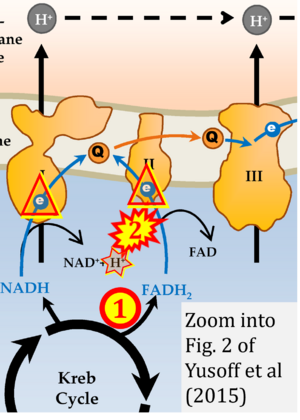Yusoff 2015 J Cancer Res Ther
| Yusoff AAM (2015) Role of mitochondrial DNA mutations in brain tumors: A mini-review. J Cancer Res Ther 11:535-44. https://doi.org/10.4103/0973-1482.161925 |
Yusoff AAM (2015) J Cancer Res Ther
Abstract: Brain tumor is molecularly a heterogeneous group of diseases, and genetic factors seem to play a crucial role in its genesis. Even though multiple alterations in the nuclear-encoded genes such as tumor suppressor and oncogenes are believed to play a key role in brain tumorigenesis, the involvement of the mitochondrial genome to this event remains controversial to date. Mitochondrial DNA (mtDNA) has been suspected to be associated with the carcinogenesis because of its high sensitivity to mutations and inefficient repair mechanisms in comparison to nuclear DNA. Thus, defects in mtDNA could also lead to the development of brain tumor. By virtue of their clonal nature and high copy number, mtDNA mutations may provide a new effective molecular biomarker for the cancer detection. It has been suggested that establishing mtDNA defective pattern might be useful in cancer diagnostics and detection, the prognosis of cancer outcome, and/or the response to certain treatments. This mini-review gives a brief overview on the several aspects of mtDNA, with a particular focus on its role in tumorigenesis and progression of brain tumor. Understanding the role of mitochondria and brain tumor development could potentially translate into therapeutic strategies for patients with these tumors.
• Bioblast editor: Gnaiger E
Correction: FADH2 and Complex II
- FADH2 is shown as the substrate feeding electrons into Complex II (CII). This is wrong and requires correction - for details see Gnaiger (2024).
- Gnaiger E (2024) Complex II ambiguities ― FADH2 in the electron transfer system. J Biol Chem 300:105470. https://doi.org/10.1016/j.jbc.2023.105470 - »Bioblast link«
Hydrogen ion ambiguities in the electron transfer system
Communicated by Gnaiger E (2023-10-08) last update 2023-11-10
- Electron (e-) transfer linked to hydrogen ion (hydron; H+) transfer is a fundamental concept in the field of bioenergetics, critical for understanding redox-coupled energy transformations.
- However, the current literature contains inconsistencies regarding H+ formation on the negative side of bioenergetic membranes, such as the matrix side of the mitochondrial inner membrane, when NADH is oxidized during oxidative phosphorylation (OXPHOS). Ambiguities arise when examining the oxidation of NADH by respiratory Complex I or succinate by Complex II.
- Oxidation of NADH or succinate involves a two-electron transfer of 2{H++e-} to FMN or FAD, respectively. Figures indicating a single electron e- transferred from NADH or succinate lack accuracy.
- The oxidized NAD+ is distinguished from NAD indicating nicotinamide adenine dinucleotide independent of oxidation state.
- NADH + H+ → NAD+ +2{H++e-} is the oxidation half-reaction in this H+-linked electron transfer represented as 2{H++e-} (Gnaiger 2023). Putative H+ formation shown as NADH → NAD+ + H+ conflicts with chemiosmotic coupling stoichiometries between H+ translocation across the coupling membrane and electron transfer to oxygen. Ensuring clarity in this complex field is imperative to tackle the apparent ambiguity crisis and prevent confusion, particularly in light of the increasing number of interdisciplinary publications on bioenergetics concerning diagnostic and clinical applications of OXPHOS analysis.
Labels:
Pathology: Cancer
Organism: Human Tissue;cell: Nervous system




